Star Wars: Outlaws, developed by Ubisoft as their first shot at a game in the universe, presents an open-world experience where players can explore the galaxy and live out their space scoundrel fantasies. Following Ubisoft Massive’s underwhelming release of Avatar: Frontiers of Pandora, this title offers an engaging galaxy and an enjoyable narrative, even if not entirely original. However, I struggled with many strange or mediocre gaming elements that could have been vastly improved if they had been left to bake for much longer. Let’s look deeper at the newest entry in the Star Wars universe.

Story:
I have been a Star Wars fan ever since a High School teacher played The Empire Strikes Back during a lunch break. I was fascinated with the light/dark side, dynamic characters, and fantastical settings. So call me a sucker, but I tend to give every entry at least a shot. We have had wildly varying quality entries into the universe, from The Acolyte to The Mandalorian, and the quality difference is stark. However, EA and Respawn Entertainment proved you could make a great Star Wars Game with Jedi: Fallen Order.
Set between Star Wars Episodes V and VI, the galaxy is in turmoil. The Empire, reeling from the destruction of the Death Star, struggles to regain control while criminal syndicates vie for power. Players step into the role of Kay Vess, a young thief from Canto Bight who, after a heist gone wrong, finds herself with a death mark and nowhere to turn. Her only hope lies with Jaylen Vrax, an enigmatic fixer, who offers her a deal: assemble a crew and pull off a daring heist targeting the vault of a powerful syndicate leader, Sliro Ruback. Your sidekick, Nix, is charming and a great tool, and the characters you encounter are well-acted.
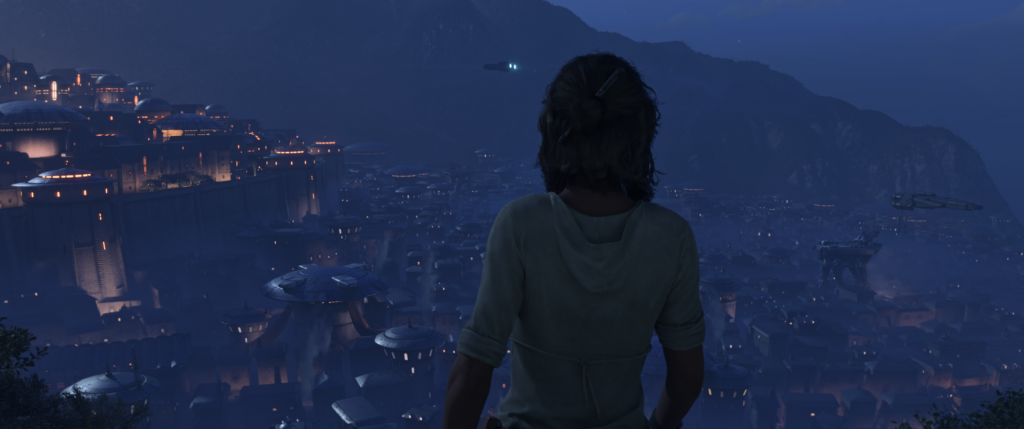
As you roam the world, you’ll encounter various species on different planets and characters to interact with. A core element is the factions you must balance with reputation scaling between how you interacted with them, what quests you completed for them, and whether or not you choose to be loyal to them. Having a good reputation unlocks many things like dialogue, shop discounts, and access to previously guarded areas with resources to gather or treasure to steal.
While the heist story provides a compelling setup with some intriguing twists, the supporting characters could benefit from further development. Kay Vess is a solid protagonist, but the rest of her crew, aside from Jaylen and his droid bodyguard ND-5, feel underdeveloped and follow predictable archetypes. This may be attributed to the open-world structure, where recruitment orders vary, limiting crew members’ interaction.
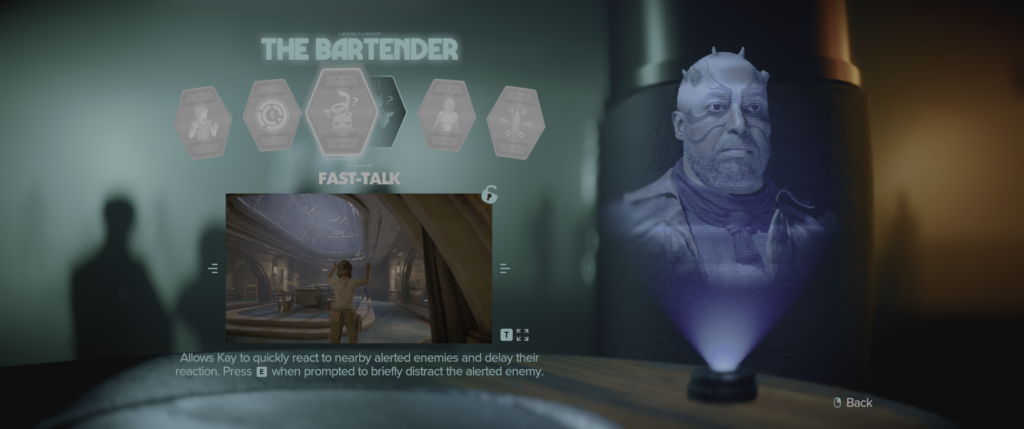
As mentioned, ND-5, the droid bodyguard, stands out as a well-developed character with a rich backstory linked to the Clone Wars, exploring themes of droid autonomy and freedom. This nuanced approach offers a fresh take on droid rights, a recurring but often lightly treated theme in Star Wars lore. Sliro is the main antagonist and is mediocre in his delivery as the looming threat, and this theme seems to seep throughout the other characters. There are some great cut scenes and beautiful set pieces. However, I rarely found a story that was uber-compelling or impactful enough to match its grandiose setting. Some were fun and challenging, but I felt it could have been more epic in scale.
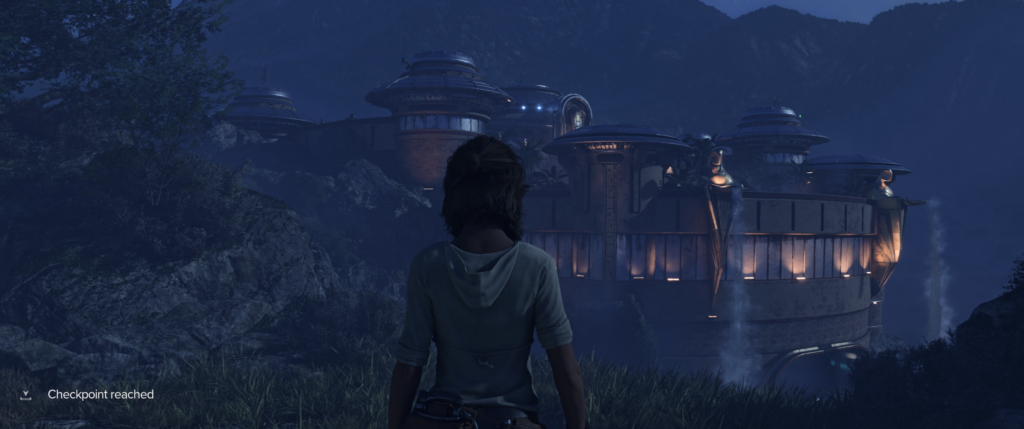
This has nothing to do with the main character being a “woman.” To clarify, Kay is a great character and is well-developed. Her motivation and the events that launch the story are set well. Still, the overall tone and delivery of the story are sadly middling in their entry and inevitably compared to the other games and media in the same universe. Yet, I enjoyed it mostly and had a lot of fun watching it play out and making the choices that would impact Kay’s future.
What brought this to my attention was the base gameplay and structure of the game.
Gameplay Mechanics:
The game integrates multiple genres, balancing stealth, combat, and space exploration. Kay is aided by Nix, her pet merqaal, who stealthfully distracts enemies and interacts with objects based on your commands. Combat includes a variety of weapons, and Kay’s blaster has unlimited ammo, maintaining a fast pace throughout most of the missions that don’t require absolute stealth. The “Adrenaline” ability is a standout feature, allowing Kay to rapidly mark and take down multiple enemies – essentially a reskin of the Red Dead Redemption feature.
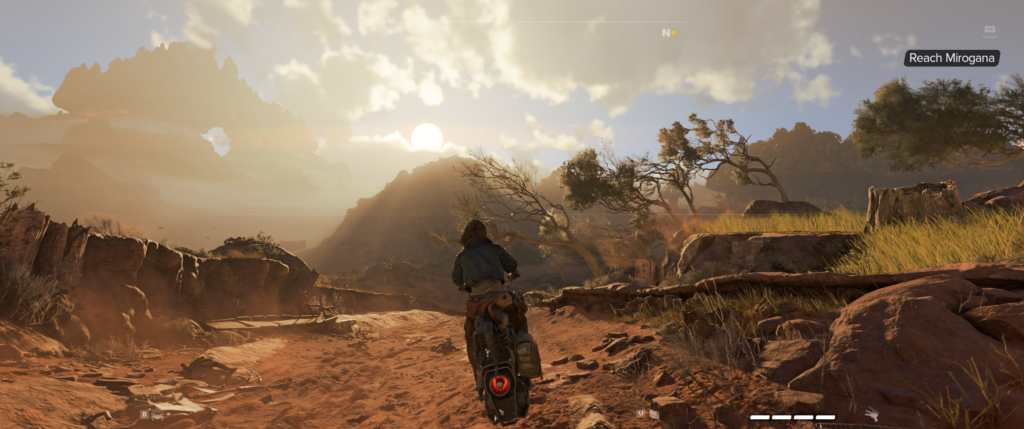
You can upgrade your blaster and pick up other weapons, but you cannot always carry something like a sniper. You can pick these up from enemies, but in one of the odd design choices, you drop your weapons when performing any other action, like climbing. For an open-world game, it’s strange that your speeder stops in its tracks and throws you off when you run into an animal or cannot steal an enemy combatant’s speeder when you end their life. Overall, it feels half-baked or unintentionally left out. It could feel like the small details were omitted when delivering the end product.
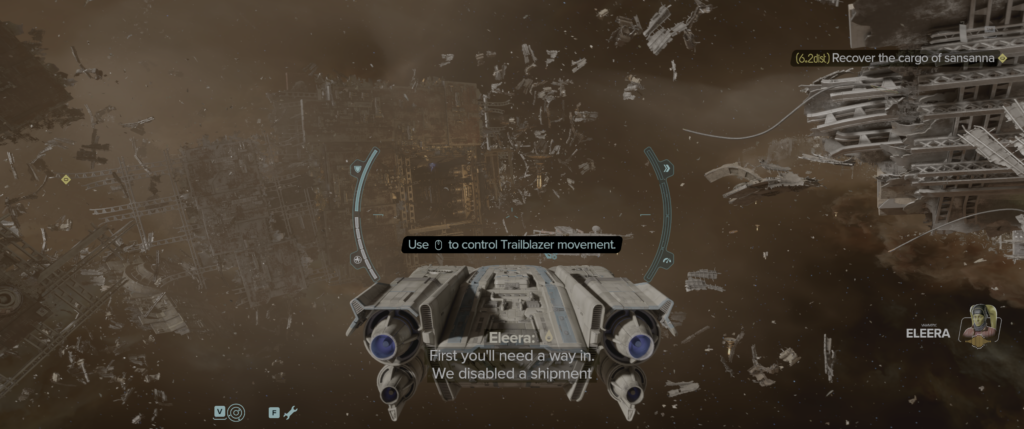
Space combat is enjoyable, albeit less complex, than titles like Star Wars: Squadrons. Kay’s ship, the Trailblazer, can be upgraded, and space encounters offer opportunities for exploration and combat.
The biggest issue with the game is it starts to become mundane throughout its story development. “Ubisoft stealth” is a ubiquitous term often used to describe how the gameplay feels and what you are sometimes forced to play, or you’ll have consequences like reputation or restarting from a checkpoint. It is just fine – stealth kills, using Nix, using your blaster to stun enemies, etc. The AI, however, is atrocious at times. This needs immediate patches and will need significant development time to improve.
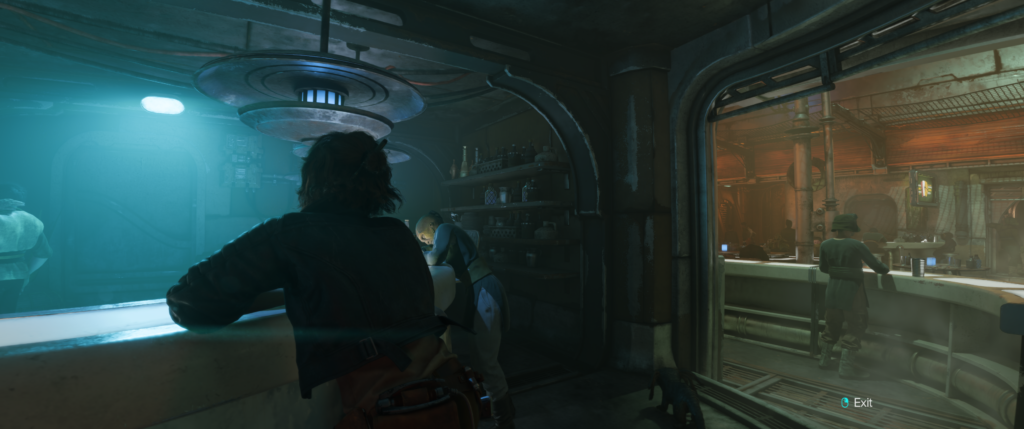
Either the enemy sees you immediately and has extreme AI accuracy or is completely befuddled by blades of grass. I was often able to expose myself to 5+ enemies, run and hide in a nearby bush well within their vision, and chase me, but as soon as I crouched, they would randomly lose me entirely. In a side world encounter, I could kill an Empire commander and some Storm Troopers – making my wanted level go up. There were others right near me, but just simply crouching and not moving let me get away with murder, literally.
Open World and Exploration:
Exploring the four main planets is a highlight of the game. The transition between space and planet surfaces is seamless, and the lack of loading screens enhances the immersive feel. Intel gathering replaces the traditional Ubisoft “Tower” mechanic, providing a more organic way to uncover points of interest. The worlds you walk through are great and have many interactable portions like arcades, race betting, and a card game (Kessel Sabacc.)
The game’s progression system avoids grindy leveling mechanics, focusing instead on equipment upgrades and skill challenges, which offer a more rewarding experience than repetitive combat.

Side Activities:
Beyond the main missions, players can engage in side quests and minigames, including speeder chases, lockpicking, and a well-developed card game called Kessel Sabacc, reminiscent of Blackjack with additional mechanics. Though the game could benefit from a clearer tutorial for this, it adds depth to the experience and provides a fun diversion. I lost way too many credits here, but no one ever won anything stopping early, right?
Reputation System:
A syndicate’s reputation system offers both benefits and limitations. Building good relationships with criminal syndicates can unlock special gear and discounts, but the consequences of ignoring the system are minimal. Some reputation losses feel arbitrary, which can detract from the overall experience. I wish it was more closely designed to imitate or expand on Mass Effect’s reputation system, but it was an interesting take, and it’s a fun diversion to choose who you want to place your future with.
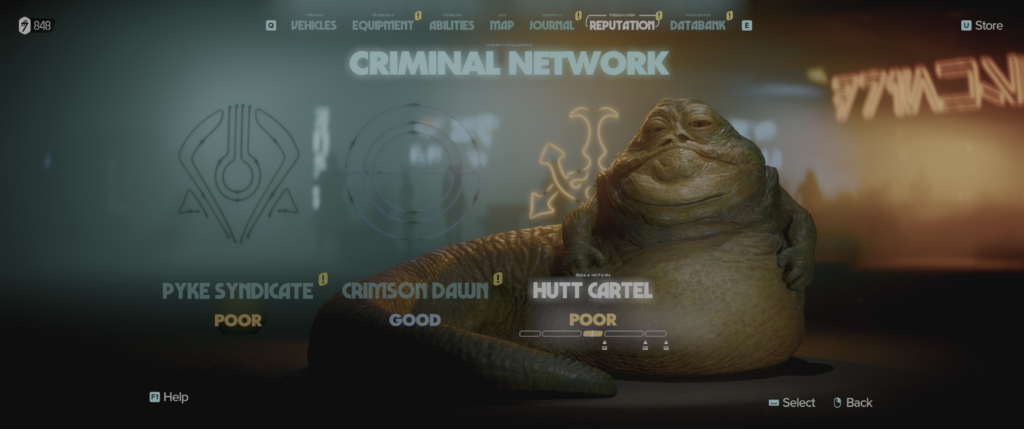
Performance:
Star Wars: Outlaws delivers an impressive visual experience, though it doesn’t quite match the cutting-edge graphics of recent Unreal Engine 5 titles. Powered by Ubisoft’s Snowdrop engine, the game captures the iconic Star Wars aesthetic through well-designed, varied environments and strong geometric detail. However, some textures and the absence of ambient occlusion leave certain areas looking less polished. Fortunately, the game avoids shader stuttering issues that plague other modern titles, and Ubisoft has included a wealth of accessibility options, making the game enjoyable for a wide range of players. I did not enjoy the mini-rhythm game for lockpicking, and this can be entirely turned off as most other mini-interactions like this can be.
Performance-wise, the game supports advanced features like Nvidia’s DLSS 3 with frame generation, AMD FSR, Intel XeSS, and ray tracing, with optional settings to enhance visuals or improve performance. The hardware requirements are high, especially for players aiming for 4K60, with top-tier GPUs needed for the best experience. Despite this, Star Wars: Outlaws manages reasonable memory management across different GPUs, and while enabling all the visual enhancements significantly reduces FPS, the game still performs admirably, particularly on Nvidia hardware. Overall, it successfully balances visual fidelity with performance, offering one of the best Star Wars gaming experiences in recent years.


We did have some heavy performance drops and crashes in some areas but these were few, I would expect this to be worse on lower-end cards even with frame generation or upscaling. Expect to wait for a couple of patches for performance improvements if you have something less beefy.
Conclusion:
Overall, Star Wars Outlaws delivers an expansive, immersive galaxy with strong lead characters and a wealth of side content. While some supporting characters and the syndicate reputation system fall short, the game excels in capturing the Star Wars atmosphere and offering varied gameplay experiences. Whether engaging in space combat, stealth missions, or card games, players will find plenty to enjoy in this open-world adventure.
However, its combat and stealth gameplay is mediocre at best, and its performance issues at launch are glaring. It comes down to the small things that stack up to make a gamer lose interest or increase the level of boredom and frustration. I wanted to always see what was next in the story – without having to crouch through more sections of stealth.
If you are a Star Wars fan, a sale might be best, but if you are itching for another adventure, you can expect a great story but with some disappointing gameplay elements. We hope this game receives more patches and optimizations so it can be experienced as intended or how it should be.
Happy gaming!
Nvidia provided this review key, this was not in exchange for a positive review and does not change our review process or influence our scores. Thank you, Nvidia!
Star Wars: Outlaws: Rating: Mediocre Positives: Immersive galaxy with seamless exploration Strong protagonists in Kay Vess Engaging skill development system Rich side content, including the Kessel Sabaac card game Negatives: Supporting characters lack depth Initial hours can feel restrictive Syndicate reputation system feels arbitrary at times Bad AI and limited gameplay variety – Mario Vasquez